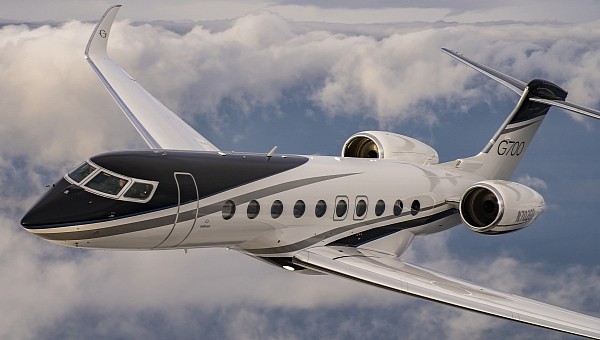Common, working-class folks may have a certain disdain for private jets. But even the most jaded among us have to tip our caps to Gulfstream Aerospace for their excellence in engineering their newest large business jet, the G700. 25 new world records for speed in its class is nothing to sneeze at in any class of airplane.
As the new G700 made a tour around the world, timing the journeys between each destination, the new twin-jet's results were nothing short of astonishing. Proceedings began with a takeoff near Gulfstream's production facility in Savannah, Georgia, USA. Precisely 12 hours and 36 minutes later, the plane landed in Riyadh, Saudi Arabia. The G700's stellar average speed of Mach 0.9, or 90 percent the speed of sound, ensured proceedings started with a bang.
The run from Istanbul, Turkey, to Vietnam's Van Don International Airport was completed in a similarly spectacular nine hours and two minutes. Matching its average speed over the trip of 90 percent of the sound barrier from the first leg once again. But perhaps the most astonishing stats were the times measured between Riyadh and Sydney, Australia, and Christchurch, New Zealand, to Los Angeles, California. Completed in 13 hours and 39 minutes, and 12 hours 30 minutes, respectively.
Compared to the Boeing and Airbus passenger jets, which most common folks are stuck flying, they seem bloated and slow compared to the G700. "The G700 world tour was a tremendous success," exclaimed Mark Burns, president of Gulfstream, after completing the G700's world tour. "We knew the aircraft would perform exceptionally well, and they exceeded even our own high expectations for both reliability and performance across various routes. Showcasing the outfitted aircraft to our customers and prospects around the world bolstered the already strong demand we see for the G700."
The G700's airframe might be all-new. But that doesn't mean the G700 does carry a few heaping helpings of heritage alongside all the people in suits. In truth, Gulfstream itself began its existence as a passenger jet design initiative under an entirely different company, Grumman Aerospace of Bethpage, New York.
The first Turboprop-powered Grumman Gulfstream I was a spectacular airframe in its day. Its first flight in 1958 was followed by a production run of 200 units sporting Rolls-Royce Dart Turbine engines. The Grumman Gulfstream I was followed up by the turbofan-powered Gulfstream II. With this jet, Gulfstream formally separated from Grumman, left New York, and became its own Georgia-based aerospace manufacturer.
Under their new independent design team, Gulfstream continued to build their second-gen business jet while working simultaneously on its successor, the Gulfstream III, introduced in 1980. This was followed up followed by the Gulfstream IV in 1985 and the Gulfstream V in 1997. It's 50 years' worth of aeronautical development that spawned the jet on which the G650, on which the G700 is based.
First flown in November 2009, the G650 set the precedent of bonking the ragged edge of the sound barrier with every flight. Test flights revealed the airframe could tolerate speeds up to Mach 0.995, although no outside adjudication confirmed whether this was a new world record. Any closer to the limit, and the airframe would sonic boom its way across any flight route it traveled along.
With the same Honeywell Primus Epic touch-screen flight deck with fly-by-wire control surfaces as the G650, the real improvements come in the forms of two new Rolls-Royce Pearl 700 turbofan engines cranking out 18,250 lbf (81.2 kN) each. Newer, more efficient engines add a further 1,350 lbs (6 Kn) of thrust over the outgoing G650, while providing up to 500 nautical miles (926 km, 575.3 mi) more range out of the G700's fuel tanks.
Cabin volume is also up over the G650 in the G700. With 2,603 cubic feet (73.7 m3) to work with over 2,138 cu ft (60.5 m3) in both the early and late G650s, there is enough room for 13 people and an extra champagne cooler or two. Or more like an entire bedroom suite plus a bathroom with a shower.
You know, like a luxury hotel suite in the gosh darn sky. Maybe an open bar if it's "that" kind of private company. Compared to stiff competition from the likes of Embraer's Legacy/Praetor line and Dassault's Falcon series, the G700 manages to have an appeal all its own.
Neither of these two competitors manages to reach the same ludicrous speeds as the Gulfstream, although the Falcon 7x might get close. But airplane specs on a stat sheet are like a drag race in your mind. Everyone only cares about which one comes in first. The notion of a business jet that could likely go supersonic if it was hooned on just a bit has an appeal few passenger jets can even come close to.
As of late 2021, there were twelve Gulfstream G700 airframes completed with an MSRP starting at $78 million. The cost to operate the jet for 500 hours? That'd be $3.5 million in itself. No wonder only people like Elon Musk and his ilk bother buying these planes. Just know whenever Elon claims his private jet is being tracked and posted to Twitter, chances are good he's doing so while getting a foot massage in his custom G700.
If that isn't the most intense 21st-century flex of the millennium, we don't know what is. All we do know is that most of us nine-to-fivers would be lucky if we caught sight of a G700 taxiing while you're waiting to board your Spirit Airlines flight. Hope you enjoy the extra fee for baggage (not).
The run from Istanbul, Turkey, to Vietnam's Van Don International Airport was completed in a similarly spectacular nine hours and two minutes. Matching its average speed over the trip of 90 percent of the sound barrier from the first leg once again. But perhaps the most astonishing stats were the times measured between Riyadh and Sydney, Australia, and Christchurch, New Zealand, to Los Angeles, California. Completed in 13 hours and 39 minutes, and 12 hours 30 minutes, respectively.
Compared to the Boeing and Airbus passenger jets, which most common folks are stuck flying, they seem bloated and slow compared to the G700. "The G700 world tour was a tremendous success," exclaimed Mark Burns, president of Gulfstream, after completing the G700's world tour. "We knew the aircraft would perform exceptionally well, and they exceeded even our own high expectations for both reliability and performance across various routes. Showcasing the outfitted aircraft to our customers and prospects around the world bolstered the already strong demand we see for the G700."
The G700's airframe might be all-new. But that doesn't mean the G700 does carry a few heaping helpings of heritage alongside all the people in suits. In truth, Gulfstream itself began its existence as a passenger jet design initiative under an entirely different company, Grumman Aerospace of Bethpage, New York.
Under their new independent design team, Gulfstream continued to build their second-gen business jet while working simultaneously on its successor, the Gulfstream III, introduced in 1980. This was followed up followed by the Gulfstream IV in 1985 and the Gulfstream V in 1997. It's 50 years' worth of aeronautical development that spawned the jet on which the G650, on which the G700 is based.
First flown in November 2009, the G650 set the precedent of bonking the ragged edge of the sound barrier with every flight. Test flights revealed the airframe could tolerate speeds up to Mach 0.995, although no outside adjudication confirmed whether this was a new world record. Any closer to the limit, and the airframe would sonic boom its way across any flight route it traveled along.
With the same Honeywell Primus Epic touch-screen flight deck with fly-by-wire control surfaces as the G650, the real improvements come in the forms of two new Rolls-Royce Pearl 700 turbofan engines cranking out 18,250 lbf (81.2 kN) each. Newer, more efficient engines add a further 1,350 lbs (6 Kn) of thrust over the outgoing G650, while providing up to 500 nautical miles (926 km, 575.3 mi) more range out of the G700's fuel tanks.
You know, like a luxury hotel suite in the gosh darn sky. Maybe an open bar if it's "that" kind of private company. Compared to stiff competition from the likes of Embraer's Legacy/Praetor line and Dassault's Falcon series, the G700 manages to have an appeal all its own.
Neither of these two competitors manages to reach the same ludicrous speeds as the Gulfstream, although the Falcon 7x might get close. But airplane specs on a stat sheet are like a drag race in your mind. Everyone only cares about which one comes in first. The notion of a business jet that could likely go supersonic if it was hooned on just a bit has an appeal few passenger jets can even come close to.
As of late 2021, there were twelve Gulfstream G700 airframes completed with an MSRP starting at $78 million. The cost to operate the jet for 500 hours? That'd be $3.5 million in itself. No wonder only people like Elon Musk and his ilk bother buying these planes. Just know whenever Elon claims his private jet is being tracked and posted to Twitter, chances are good he's doing so while getting a foot massage in his custom G700.












